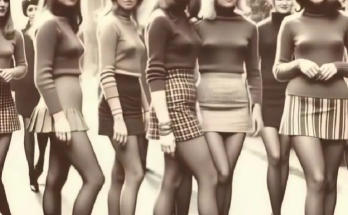Step Into the Shadows With the Queen of Dark
In a world saturated with glittering influencers, sun-drenched selfies, and pastel-filtered fashion, one woman has emerged as the reigning monarch of mystery. She’s not basking in golden hour light. She’s cloaked in black. She’s not chasing likes with smiley poses—she’s haunting timelines with her ethereal stillness, piercing gaze, and unapologetic darkness. She is known only as The Queen of Dark, and stepping into her shadows is stepping into something deeper than fashion—it’s a philosophy.
Who Is the Queen of Dark?
Her real name is Nyakim Gatwech, a South Sudanese-American model who has captivated millions not by trying to look like anyone else—but by embracing everything that once made her feel “other.” Her skin, darker than obsidian, has become her crown. Her fashion, bold and unapologetically gothic, makes a statement in every frame. And her silence, when she stares into the lens, speaks volumes.
Her moniker, Queen of Dark, began as a nickname whispered online in admiration and awe. But Nyakim took it, owned it, and turned it into her throne.
The Rise of a Dark Icon
Nyakim’s journey wasn’t always regal. Born in a refugee camp in Ethiopia and raised between cultures in the United States, she often found herself the target of racist remarks and harsh bullying because of her deeply pigmented skin. She recalls strangers asking if she bleached at night. Uber drivers suggesting skin lightening. Modeling agencies turning her away, telling her she was “too different.”
But she didn’t fold. She transformed pain into pride.
She once shared:
“My skin is my weapon. You can’t dim the sun, and you sure as hell can’t dim me.”
This defiance—paired with her visual power—sparked a following. Nyakim began posting photos that celebrated her dark skin unapologetically. She styled herself in black and crimson gowns, sleek silver jewelry, matte-black lipstick, and high-drama lighting. Her aesthetic evolved into something gothic, mythical, and queenly.
The world noticed.
Fashion houses called. Editorials were booked. And her Instagram exploded with people praising her not just as a model, but as a movement.
Aesthetic as Rebellion
The Queen of Dark’s style isn’t just about beauty—it’s a confrontation.
In a culture that associates lightness with beauty, safety, and worthiness, she dares to pose in ink-black gowns, in dimly lit alleys, with shadows cast across her high cheekbones. Her use of darkness isn’t accidental—it’s a bold reclamation.
Her photos often mirror renaissance paintings—rich in texture and contrast. Black lipstick. Black leather. Black lace. Her wardrobe looks less like the mall and more like an ancient cathedral, drawing from both goth and Afrofuturist influences.
Nyakim doesn’t just wear black. She is black in every sense—unapologetically African, defiantly different, and rooted in ancestral strength. When she steps in front of a camera, she is both storm and sculpture.
The Gothic Feminine Reborn
The Queen of Dark redefines what it means to be feminine in a visual culture. There are no soft curls, no bubblegum pink, no helplessness in her gaze. Instead, there is control. Command. Mystery.
In an era where much of femininity is about openness—she withholds. Her silence, her intensity, becomes its own kind of power.
Many see her as the embodiment of the “dark feminine”—a rising archetype celebrating shadow, sensuality, depth, and emotional power. She stands in contrast to the overly curated, girl-next-door aesthetic popular on social media. Instead of shrinking to be liked, she expands into her full presence.
Global Reaction
Fans from every continent have poured into her comment sections with awe and adoration.
“She looks like a goddess sculpted from the night,” one wrote.
“Not just melanin. This is art.”
But not all reactions have been positive. With fame came backlash—from racist trolls, from beauty traditionalists, from those who fear or misunderstand her intensity. But that’s exactly why her presence matters. She has become both icon and lightning rod. And she handles it with the composure of royalty.
Nyakim’s message is clear: beauty is not one shade, one tone, or one style. True power lies in authenticity.
Behind the Lens
Her collaborators speak of Nyakim as more than a model.
“She doesn’t just show up and pose,” one photographer said. “She transforms the room. Suddenly, you’re not in a studio—you’re in her kingdom.”
She chooses photographers who understand mood, who play with shadows and silhouettes, who aren’t afraid to go dark—both literally and artistically. Lighting becomes ritual. Costumes become armor. Makeup becomes mask and magic.
Her favorite shoots often happen at night, in abandoned locations, or under moonlight. The darker the set, the more she shines.
Not Just Looks—Legacy
Despite the fame, Nyakim hasn’t strayed from her purpose. She uses her platform to talk about colorism, self-love, and cultural pride. She frequently speaks to young girls of color, especially in African and diaspora communities, reminding them that their skin is not a curse—but a crown.
She has supported education projects in East Africa, partnered with brands for inclusive beauty lines, and spoken out about mental health. The Queen of Dark is not just a figure—she’s a force.
“I don’t need to be the face of every brand,” she once said. “I just want to be a mirror. For the girls who’ve never seen someone like them worshipped, I want to be proof that they’re divine.”
Into the Shadows
To step into the shadows with the Queen of Dark is to step into a world where power doesn’t require permission. Where beauty comes in obsidian tones and silence holds more weight than words. It’s to question everything you thought you knew about what a woman should look like.
In a time when everyone is trying to look the same, she reminds us what it means to stand alone—and still command a kingdom.
She is not chasing light. She is her own eclipse.


